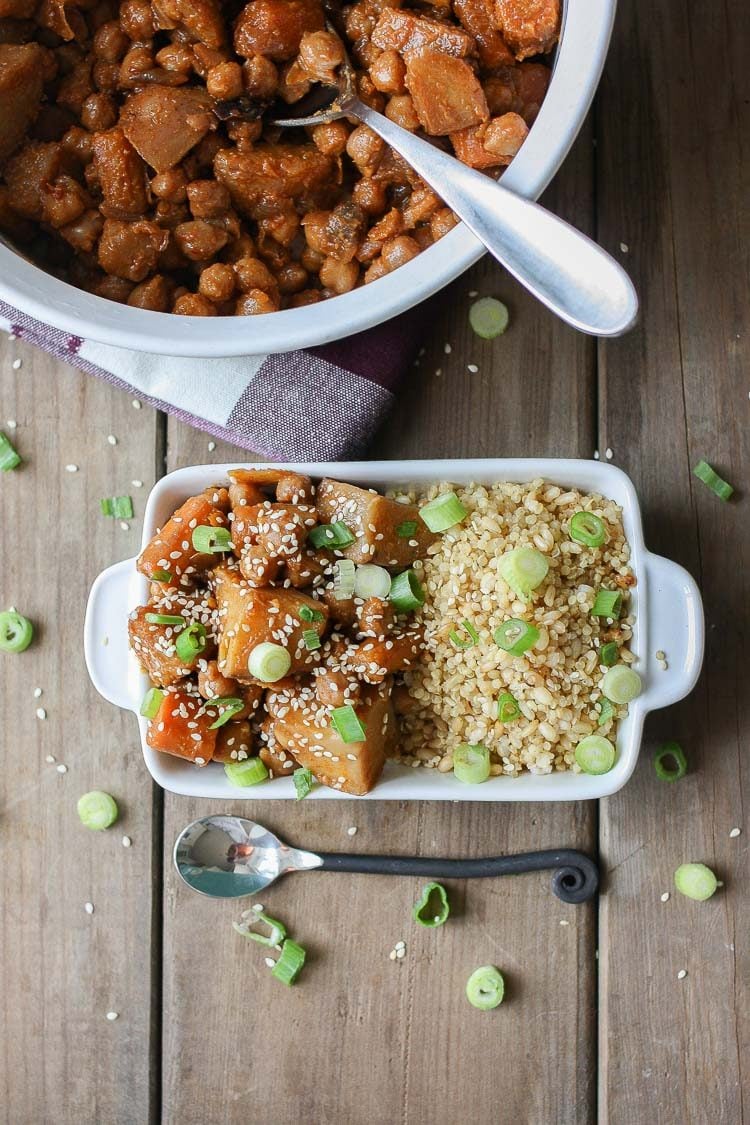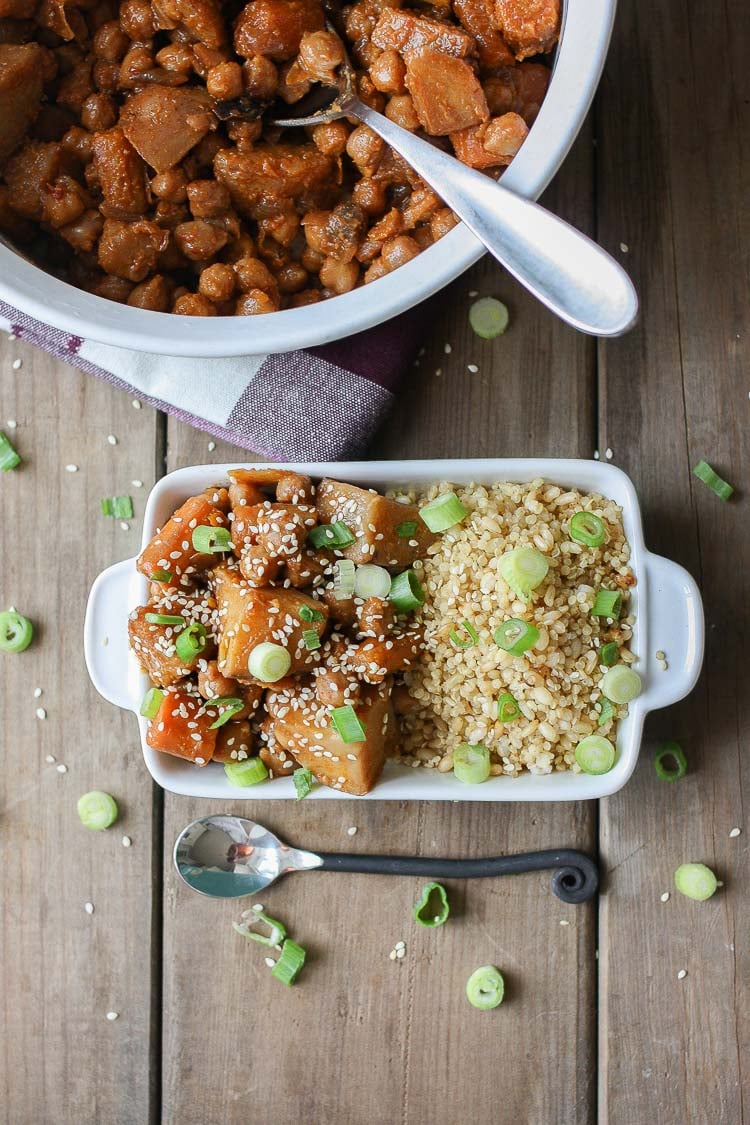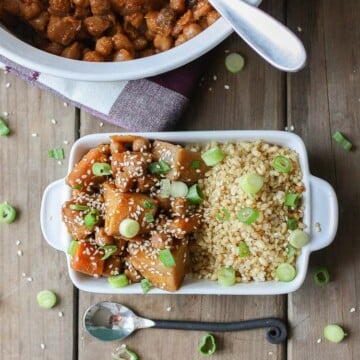Contents
- I. Introduction to Korean Chickpeas, Carrots And Potatoes
- II. The Health Benefits of Korean Chickpeas, Carrots And Potatoes
- III. Traditional Korean Recipes Featuring Chickpeas, Carrots And Potatoes
- IV. How to Prepare and Cook Korean Chickpeas, Carrots And Potatoes
- V. Where to Buy Korean Chickpeas, Carrots And Potatoes
- VI. Frequently Asked Questions about Korean Chickpeas, Carrots And Potatoes
- 1. Are chickpeas commonly used in Korean cuisine?
- 2. Can I substitute other types of legumes for chickpeas?
- 3. What makes this Korean dish unique?
- 4. Can I adjust the level of spiciness in this dish?
- 5. Is this recipe suitable for vegetarians or vegans?
- 6. Can I make this dish gluten-free?
- 7. How long does it take to cook Korean Chickpeas, Carrots Andamp; Potatoes?
- 8. Can I store leftovers?
- 9. Can I freeze this dish?
- 10. What are some serving suggestions for this dish?
I. Introduction to Korean Chickpeas, Carrots And Potatoes

Welcome to the flavorful world of Korean cuisine! In this article, we will explore a delightful dish called Korean Chickpeas, Carrots Andamp; Potatoes. This hearty and nutritious meal combines the goodness of protein-rich chickpeas with the earthy flavors of carrots and potatoes.
As our taste buds crave for new experiences, it’s always exciting to venture into diverse culinary traditions. Korean cuisine is known for its bold flavors, vibrant colors, and unique ingredients that come together harmoniously in each dish. The combination of chickpeas, carrots, and potatoes reflects this spirit perfectly.
The Health Benefits
Before we dive into the recipe details, let’s take a moment to appreciate the health benefits these ingredients bring.
Chickpeas: These legumes are packed with nutrients like protein, fiber, vitamins (such as folate), minerals (such as iron and magnesium), and antioxidants. Consuming chickpeas regularly can help improve digestion, promote heart health, manage weight effectively due to their high fiber content while providing sustained energy levels.
Carrots: These vibrant orange root vegetables are rich in beta-carotene—a precursor to vitamin A—and contain other essential nutrients like vitamin K1 and potassium. Incorporating carrots into your diet supports eye health due to their high antioxidant content while boosting immunity and promoting healthy skin.
Potatoes: This versatile tuberous vegetable is a great source of carbohydrates for energy production. They also provide important micronutrients such as potassium and vitamin C. Contrary to popular belief about avoiding potatoes due to their starch content; they can be part of a healthy diet when prepared without excessive frying or added unhealthy fats.
The Flavorful Harmony
When combined in this Korean dish, the flavors of chickpeas, carrots, and potatoes complement each other beautifully. The nutty undertones of chickpeas merge with the natural sweetness of carrots and the mild earthiness of potatoes to create a balanced and satisfying meal.
In addition to their individual health benefits, these ingredients work together to enhance the overall nutritional value of the dish. The combination ensures a good balance of macronutrients (carbohydrates, protein, and fats) while providing a substantial amount of dietary fiber.
Recipe Inspiration
Now that you understand why Korean Chickpeas, Carrots Andamp; Potatoes are worth trying let’s move on to how you can prepare this delicious dish in your own kitchen. Stay tuned for our upcoming section where we will present an easy-to-follow recipe that captures the essence of Korean cuisine!
II. The Health Benefits of Korean Chickpeas, Carrots And Potatoes

Korean cuisine is known for its vibrant flavors and nutrient-rich ingredients. One popular dish that showcases the health benefits of Korean ingredients is the combination of chickpeas, carrots, and potatoes. This trio not only creates a delicious culinary experience but also provides numerous health benefits.
1. Excellent Source of Fiber
Chickpeas, carrots, and potatoes are all excellent sources of dietary fiber. Fiber plays a crucial role in digestion by promoting regular bowel movements and preventing constipation. It also helps to control blood sugar levels and lower cholesterol levels.
2. Rich in Antioxidants
All three ingredients are packed with antioxidants that help protect the body against free radicals – unstable molecules that can damage cells and contribute to aging and chronic diseases such as heart disease and cancer.
3. Supports Weight Management
The high fiber content in chickpeas, carrots, and potatoes can aid in weight management by promoting feelings of fullness after meals. Additionally, these ingredients have a low glycemic index, meaning they won’t cause rapid spikes in blood sugar levels.
4. Boosts Immunity
Korean chickpeas contain essential nutrients like vitamin C and zinc that support a healthy immune system. Carrots are rich in beta-carotene – a precursor to vitamin A – which plays a vital role in maintaining strong immunity as well as promoting healthy skin.
5. Promotes Heart Health
Potatoes offer several heart-healthy benefits due to their potassium content which helps maintain normal blood pressure levels. Chickpeas contain soluble fiber which can help reduce LDL cholesterol levels while increasing HDL cholesterol – both important factors in maintaining heart health.
6. Provides Essential Vitamins and Minerals
Carrots are an excellent source of vitamin A, which is essential for good vision and overall eye health. Potatoes are rich in vitamin B6, a nutrient that supports brain function and helps produce serotonin – a neurotransmitter that regulates mood.
III. Traditional Korean Recipes Featuring Chickpeas, Carrots And Potatoes

When it comes to traditional Korean cuisine, the vibrant flavors and unique combinations of ingredients are truly captivating. In this section, we will explore some delightful recipes that showcase the versatility of chickpeas, carrots, and potatoes in Korean cooking.
1. Kongbiji Jjigae (Soybean Stew)
Kongbiji jjigae is a hearty stew made from ground soybeans and various vegetables. To add a twist to this classic dish, you can incorporate chickpeas for added texture and flavor. The creamy consistency of the stew blends perfectly with the earthy taste of chickpeas.
2. Gamja Jorim (Braised Potatoes)
A staple side dish in Korean cuisine, gamja jorim features bite-sized potatoes glazed with a savory soy-based sauce. By including carrots alongside the potatoes, you not only enhance the visual appeal but also introduce a subtle sweetness that complements the overall taste.
3. Dakdoritang (Spicy Chicken Stew)
Dakdoritang is a fiery chicken stew packed with bold flavors and tender meat chunks. For a vegetarian twist on this popular dish, substitute chicken with boiled chickpeas while maintaining all other elements such as spicy gochujang paste and aromatic vegetables like carrots and potatoes.
4. Hobak Juk (Pumpkin Porridge)
Hobak juk is a comforting porridge often enjoyed as breakfast or dessert in South Korea. Adding mashed chickpeas to this sweet pumpkin-based porridge creates an interesting contrast between smoothness and nutty texture while enriching its nutritional profile.
5. Gamjajeon (Potato Pancakes)
Gamjajeon, or potato pancakes, are a popular street food in Korea. To elevate this simple yet delicious snack, you can incorporate shredded carrots and mashed chickpeas into the batter. The combination of crispy edges, soft centers, and the subtle sweetness from carrots will leave you craving for more.
These traditional Korean recipes demonstrate how chickpeas, carrots, and potatoes can be seamlessly integrated into the rich tapestry of Korean cuisine. By exploring these delightful dishes, you’ll not only expand your culinary horizons but also appreciate the creativity that flourishes within Korean gastronomy.
IV. How to Prepare and Cook Korean Chickpeas, Carrots And Potatoes

Are you ready to embark on a culinary adventure with Korean flavors? This recipe for Korean chickpeas, carrots, and potatoes is a delightful combination of healthy ingredients and vibrant flavors. Follow these simple steps to prepare and cook this delicious dish:
Gather the Ingredients
Before you start cooking, make sure you have all the necessary ingredients. Here’s what you’ll need:
- 1 can of chickpeas
- 2 medium-sized carrots
- 4 small potatoes
- 1 tablespoon sesame oil
- 1 tablespoon soy sauce
- 1 teaspoon honey or maple syrup (optional)
- Salt and pepper to tasteAndlt;/l
V. Where to Buy Korean Chickpeas, Carrots And Potatoes

When it comes to finding high-quality Korean chickpeas, carrots, and potatoes, there are several options available both online and offline. Whether you prefer the convenience of online shopping or the experience of browsing through local stores, here are some places where you can purchase these ingredients:
1. Online Retailers
Online retailers offer a wide range of Korean food products including chickpeas, carrots, and potatoes. Websites such as Amazon, Hmart.com, and AsianFoodGrocer.com have a vast selection of authentic Korean ingredients that can be conveniently delivered to your doorstep.
2. Local Asian Supermarkets
If you enjoy exploring local markets and want to see the products firsthand before purchasing them, visiting an Asian supermarket is a great option. These supermarkets often stock a variety of fresh produce from different cultures including Korean staples like chickpeas, carrots, and potatoes.
3. Farmers Markets
Farmers markets are an excellent place to find locally grown produce including fresh vegetables like chickpeas, carrots, and potatoes. Many farmers markets now also feature vendors who specialize in offering international ingredients such as those found in Korean cuisine.
4. Specialty Food Stores
In major cities or areas with a significant Korean population, specialty food stores dedicated to Asian cuisine can be found easily. These stores typically carry an extensive range of authentic Korean ingredients sourced directly from Korea.
5. Online Marketplaces for Organic Produce
If you prefer organic options for your kitchen creations or have specific dietary preferences or requirements when it comes to sourcing your ingredients sustainably-grown without pesticides or chemicals – consider exploring online marketplaces that specialize in organic produce. Websites like Thrive Market and FreshDirect offer a variety of organically grown Korean chickpeas, carrots, and potatoes.
Wherever you choose to purchase your Korean chickpeas, carrots, and potatoes, it’s essential to ensure that the products are fresh and of good quality. Consider reading customer reviews or checking for certifications on the websites or packaging to make an informed decision.
VI. Frequently Asked Questions about Korean Chickpeas, Carrots And Potatoes
1. Are chickpeas commonly used in Korean cuisine?
While chickpeas are not traditionally a staple ingredient in Korean cuisine, they have gained popularity as a versatile and nutritious addition to various dishes. In recent years, Korean chefs and home cooks have started incorporating chickpeas into their recipes to add protein and texture.
2. Can I substitute other types of legumes for chickpeas?
Absolutely! If you don’t have access to chickpeas or prefer other legumes, you can easily substitute them with beans like black beans or kidney beans. However, keep in mind that the flavor profile may vary slightly.
3. What makes this Korean dish unique?
Korean Chickpea, Carrot Andamp; Potato is unique due to its distinct blend of flavors derived from the combination of traditional Korean spices such as gochujang (Korean chili paste), garlic, ginger, and soy sauce. The dish offers a balance between spicy, savory, and slightly sweet flavors.
4. Can I adjust the level of spiciness in this dish?
Absolutely! The spiciness level can be adjusted according to your personal preference by adding more or less gochujang (Korean chili paste) or red pepper flakes during the cooking process.
5. Is this recipe suitable for vegetarians or vegans?
Yes! This recipe is suitable for both vegetarians and vegans as it doesn’t contain any animal products. It’s a great option for those following plant-based diets looking for flavorful and satisfying meals.
6. Can I make this dish gluten-free?
Yes, you can easily make this dish gluten-free by using tamari or a gluten-free soy sauce alternative instead of regular soy sauce. Ensure that the other ingredients used are also gluten-free.
7. How long does it take to cook Korean Chickpeas, Carrots Andamp; Potatoes?
The cooking time for this dish is approximately 30-40 minutes. It may vary depending on the size and texture of the vegetables used.
8. Can I store leftovers?
Absolutely! Leftovers can be stored in an airtight container in the refrigerator for up to 3 days. However, it’s best to consume them within 1-2 days for optimal freshness.
9. Can I freeze this dish?
Yes, you can freeze Korean Chickpeas, Carrots Andamp; Potatoes for later use. Allow the dish to cool completely before transferring it into freezer-safe containers or bags. It can be stored in the freezer for up to 2 months.
10. What are some serving suggestions for this dish?
This flavorful Korean dish pairs well with steamed rice or noodles and makes a delicious standalone meal option as well. You can also serve it alongside other traditional Korean side dishes like kimchi or pickled vegetables for a complete dining experience.Andlt;/p

Nicole Allen is a highly skilled and passionate content writer, specializing in SEO. With a strong command of the English language, Nicole has honed her writing skills to deliver engaging and informative content to her readers. Her educational background includes a Bachelor’s degree in English Literature from the University of California, Berkeley. Nicole’s love for veganism and sustainable living has fueled her dedication to creating content that promotes a cruelty-free lifestyle. Her extensive knowledge of plant-based nutrition and ethical consumerism allows her to craft compelling articles that inspire and educate readers on the benefits of embracing a vegan lifestyle.
